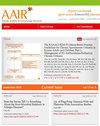人类血液代谢物与哮喘之间的因果关系:孟德尔随机化研究
IF 4.1
2区 医学
Q2 ALLERGY
引用次数: 0
摘要
背景:哮喘是一种慢性炎症性呼吸道疾病,其特征是可变气流阻塞和支气管反应性增高。尽管治疗取得了进步,但对其潜在代谢机制的全面理解仍然难以捉摸。代谢组学已成为研究血清代谢物与疾病发病机制之间复杂联系的有力方法。然而,探索血清代谢物与哮喘易感性之间的因果关系需要细致的检查,以揭示潜在的治疗靶点。方法:采用孟德尔随机化方法探讨血清代谢物与哮喘风险之间的潜在因果关系。分析主要采用方差反加权法,辅以MR-Egger、加权中位数、加权众数、样本众数等方法。为了提高结果的强度和可信度,我们进行了敏感性分析,包括异质性测试、水平多效性评估和遗漏分析。此外,还进行了途径富集分析以进一步阐明结果。结果:我们确定了18种已知代谢物和12种未知代谢物与哮喘风险的潜在关联。在已知的代谢物中,有7种具有保护作用(如4-乙酰氨基丁酸酯、尿囊素、犬尿氨酸、氧化胆红素*),而11种被认为是危险因素(如鸟氨酸、n -乙酰鸟氨酸、丙氨酸)。通过整合另外四个MR模型和敏感性分析,我们揭示了4-乙酰氨基丁酸盐与哮喘风险降低约6%之间的联系(OR = 0.94, 95% CI: 0.90-0.98)。结论:我们的MR分析揭示了保护性和风险相关的代谢物,以及12种与哮喘相关的未知代谢物。值得注意的是,4-乙酰氨基丁酸酯显示哮喘风险降低6%,突出了其潜在意义。本文章由计算机程序翻译,如有差异,请以英文原文为准。
Causal Link between Human Blood Metabolites and Asthma: An Investigation Using Mendelian Randomization
Background: Asthma, a chronic inflammatory respiratory ailment, is characterized by variable airflow obstruction and heightened bronchial reactivity. Despite therapeutic advancements, a comprehensive comprehension of its underlying metabolic mechanisms remains elusive. Metabolomics has emerged as a powerful approach to investigating the complex connections between serum metabolites and disease pathogenesis. However, exploring the causal relationship between serum metabolites and asthma susceptibility demands meticulous examination to unveil potential therapeutic targets. Methods: Mendelian randomization (MR) approach was explored to investigate the potential causal associations between serum metabolites and asthma risk. The main analysis employed the inverse variance weighted method, supported by supplementary approaches such as MR-Egger, weighted median, weighted mode, and sample mode. To enhance the strength and credibility of our results, we conducted sensitivity analyses encompassing heterogeneity testing, assessment of horizontal pleiotropy, and leave-one-out analysis. Additionally, pathway enrichment analysis was performed to further elucidate the results. Results: We identified 18 known and 12 unknown metabolites with potential associations with asthma risk. Among known metabolites, seven exhibited protective effects (e.g., 4-acetamidobutanoate, allantoin, kynurenine, oxidized bilirubin*), while eleven were considered risk factors (e.g., ornithine, N-acetylornithine, alanine). Through the integration of four additional MR models and sensitivity analyses, we revealed a connection between 4-acetamidobutanoate and approximately 6% lower asthma risk (OR = 0.94, 95% CI: 0.90–0.98). Conclusions: Our MR analysis uncovered protective and risk-associated metabolites, alongside 12 unknown metabolites linked to asthma. Notably, 4-acetamidobutanoate demonstrated a nominal 6% reduction in asthma risk, highlighting its potential significance.
求助全文
通过发布文献求助,成功后即可免费获取论文全文。
去求助
来源期刊

Allergy, Asthma & Immunology Research
ALLERGY-IMMUNOLOGY
CiteScore
6.10
自引率
6.80%
发文量
53
审稿时长
>12 weeks
期刊介绍:
The journal features cutting-edge original research, brief communications, and state-of-the-art reviews in the specialties of allergy, asthma, and immunology, including clinical and experimental studies and instructive case reports. Contemporary reviews summarize information on topics for researchers and physicians in the fields of allergy and immunology. As of January 2017, AAIR do not accept case reports. However, if it is a clinically important case, authors can submit it in the form of letter to the Editor. Editorials and letters to the Editor explore controversial issues and encourage further discussion among physicians dealing with allergy, immunology, pediatric respirology, and related medical fields. AAIR also features topics in practice and management and recent advances in equipment and techniques for clinicians concerned with clinical manifestations of allergies and pediatric respiratory diseases.
 求助内容:
求助内容: 应助结果提醒方式:
应助结果提醒方式:


